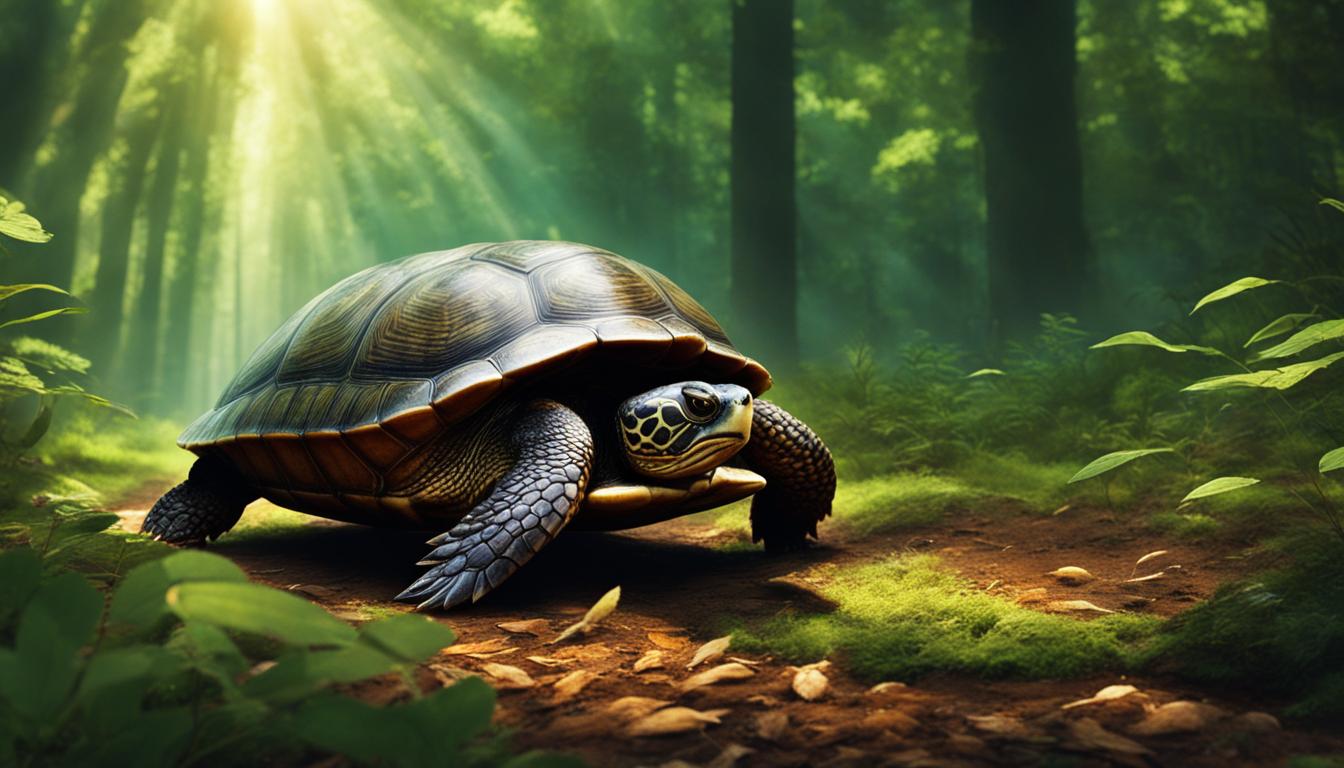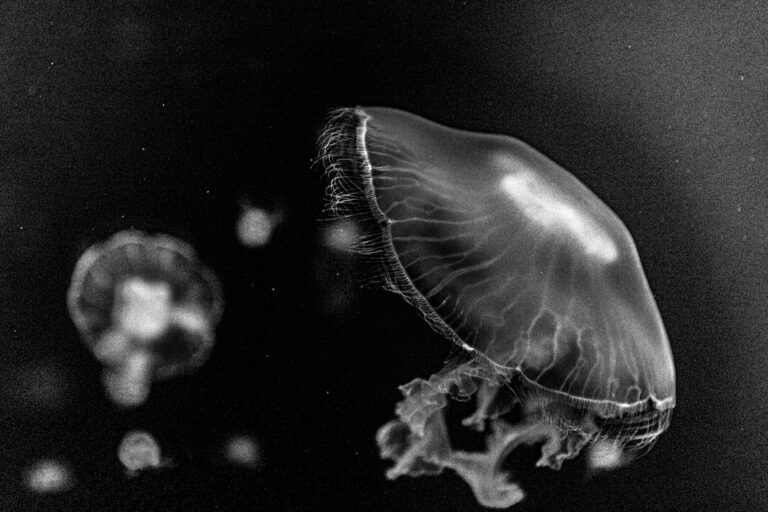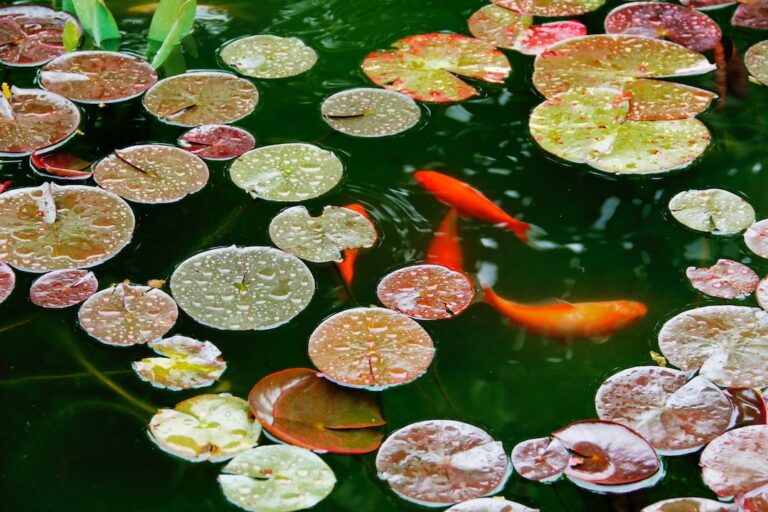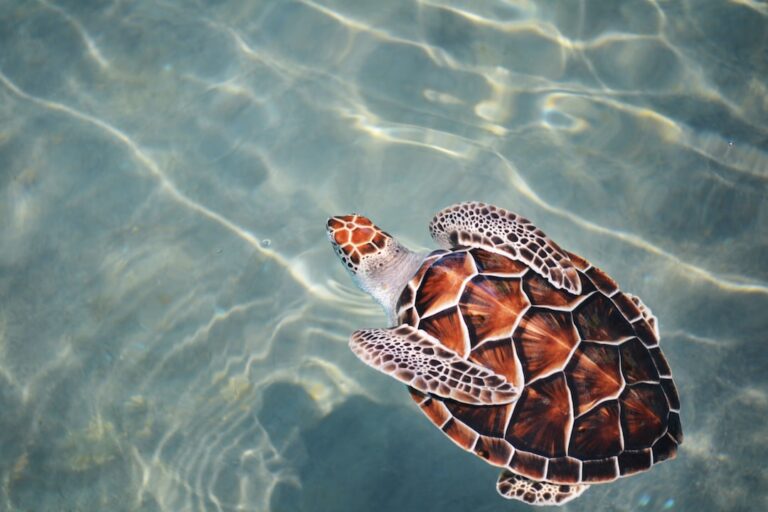Why Are Turtles So Slow?
Turtles are fascinating creatures known for their slow speed. Have you ever wondered why they move at such a leisurely pace? In this article, we will delve into the factors that contribute to a turtle’s slow speed and explore the advantages it offers them in their natural habitat.
One of the key factors behind a turtle’s slow speed is their reptilian nature. These cold-blooded creatures have a slow metabolic rate, which affects their overall energy levels and movement. Additionally, turtles have unique lifestyle and dietary habits that further contribute to their leisurely pace. Their slow and deliberate movements allow them to conserve energy and navigate their environment with precision.
Table of Contents
Key Takeaways:
- Turtles have a slow speed due to their reptilian nature and slow metabolic rate.
- Their slow movements contribute to energy conservation and precise navigation.
- Their unique lifestyle and dietary habits also play a role in their slow pace.
The Evolutionary Benefits of Slowness in Turtles
Turtles have evolved to be slow-moving creatures for several reasons. One of the key benefits of their slow speed is increased longevity. Their low metabolic rate contributes to their long lifespan by allowing them to conserve energy and sustain themselves during periods of scarcity. This adaptation has been crucial for their survival in various habitats.
Longevity Linked to Metabolic Rate
A turtle’s slow metabolic rate is a significant factor in their longevity. With their energy-conserving lifestyle, turtles can go for extended periods without needing to eat. This ability to endure prolonged fasting periods enables them to survive in environments where food availability is limited. By functioning efficiently at a slow pace, turtles are able to maximize their lifespan and adapt to challenging conditions.
Lifestyle and Dietary Habits of Turtles
The slow speed of turtles aligns with their lifestyle and dietary habits. Many turtle species have a herbivorous diet, consuming plant matter, which allows them to rely on abundant vegetation rather than chasing after elusive prey. Their slow movement allows them to graze leisurely, efficiently extracting nutrients from their food sources. This dietary strategy provides them with the necessary nutrition while minimizing the energy expended in search of food.
Moreover, turtles are generally not aggressive predators, and their slow speed encourages a lifestyle focused on defensive measures rather than active hunting. Their passive feeding habits and limited movements also reduce the risk of attracting predators or engaging in energy-intensive pursuits.
Evolutionary Adaptations to Predation
In order to survive in a world full of predators, turtles have developed several evolutionary adaptations. Their slow speed plays a critical role in these defense mechanisms. Many species have evolved protective shells that provide a shield against their predators. The shell serves as a physical barrier, discouraging predators and reducing the need for fast escape maneuvers.
Turtles also have the ability to retract their head, limbs, and tail into their shells, further enhancing their defense strategy. By withdrawing into their protective shell, turtles can minimize their vulnerability to predation, as their vital body parts are shielded from potential threats.
Furthermore, the ability to camouflage is another evolutionary adaptation that enables turtles to blend into their surroundings and avoid detection. Their slow movements, coupled with their camouflaged appearance, make it challenging for predators to locate them in their natural habitats.
| Evolutionary Benefits of Slow Speed in Turtles | |
|---|---|
| Increased longevity | The slow speed allows turtles to conserve energy and maximize their lifespan. |
| Efficient dietary habits | The slow movement aligns with their herbivorous diet, minimizing the need for fast hunting pursuits. |
| Protective adaptations | The slow speed complements their defensive mechanisms, such as their protective shells and ability to retract into their shells. |
Distinguishing between Land and Sea Turtle Speed
When it comes to turtles, speed is not a characteristic that immediately comes to mind. However, it’s essential to differentiate between the speed of land turtles and sea turtles. Land turtles, such as the Eastern Box Turtle and the Gopher Tortoise, are typically known for their slow movement on land. However, sea turtles have the ability to reach remarkable speeds in the water, making them agile marine creatures.
The discrepancy in speed between land and sea turtles can be attributed to their habitats. Land turtles are primarily adapted to terrestrial environments and have limbs designed for navigating slower-paced settings. On the other hand, sea turtles have streamlined bodies and flippers that enable them to propel through the water with ease.
Sea turtles, such as the Green Sea Turtle and the Leatherback Turtle, have evolved to be highly efficient swimmers. They possess powerful front flippers that allow them to generate significant propulsion and maneuver swiftly in the ocean currents.
To highlight the differences in speed between land and sea turtles, let’s take a look at some specific characteristics and adaptations:
Land Turtles:
- Have short, sturdy limbs designed for walking on land
- Tend to have a more rounded shell shape, offering protection in their terrestrial habitats
- Favor a slower pace and primarily rely on their shell for defense
Sea Turtles:
- Have long, streamlined bodies and powerful front flippers for swimming
- Often feature a more flattened shell shape, aiding in aquatic agility
- Can reach speeds of up to 20 miles per hour (32 kilometers per hour) in short bursts
Understanding the distinctions in speed between land and sea turtles helps us appreciate the unique adaptations that each species has developed to thrive in their respective habitats. While land turtles embrace a slower pace on land, sea turtles demonstrate their remarkable agility and speed in the vast ocean waters.
Anatomy of a Turtle: The Role of the Shell
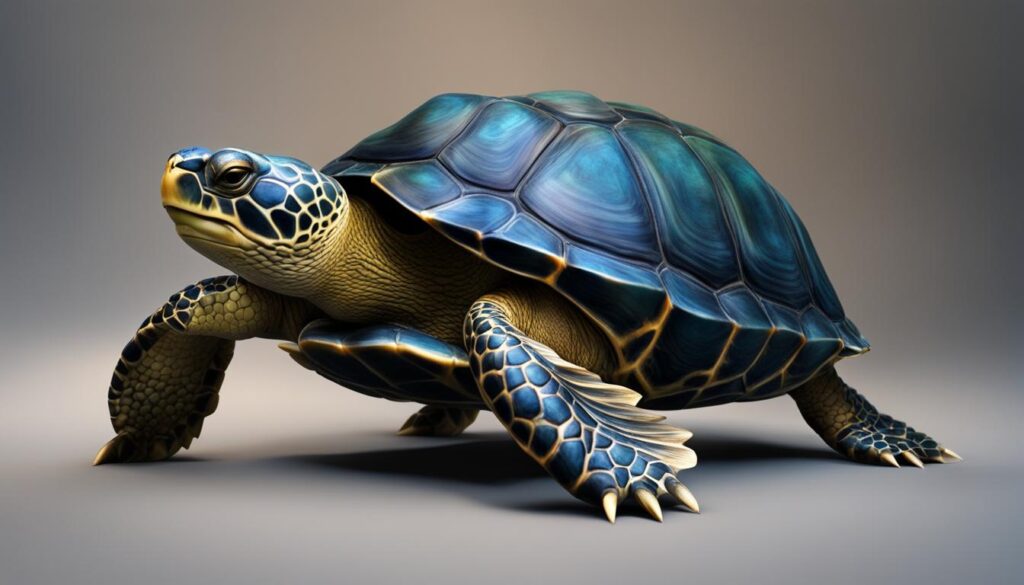
Turtles possess a unique anatomy, with one of their most distinctive features being their shells. The shell serves as a vital component of a turtle’s body, providing not only protection but also influencing its mobility and overall speed.
Weight and Mobility: Trade-offs of Protection
The turtle shell consists of two main parts: the upper carapace and the lower plastron. These bony structures are fused to the turtle’s skeleton and encase its body, acting as a suit of armor. While the shell offers excellent protection against predators, it does come with trade-offs in terms of weight and mobility.
The shell’s weight can be a hindrance to a turtle’s speed. As turtles carry their shells wherever they go, the additional weight affects their ability to move quickly. The sheer bulk of the shell requires more energy and effort to maneuver.
However, turtles have developed various adaptations to overcome this challenge. Their limbs and muscles have evolved to support the weight of the shell while providing enough strength for movement. Additionally, the shape of the shell allows for efficient weight distribution, making it easier for a turtle to maintain balance and navigate its environment.
Shell Evolution: From Prehistoric Turtles to Modern Forms
The evolution of the turtle shell is a fascinating journey that spans millions of years. Fossil records reveal that prehistoric turtles had shells that were not as fully developed as the shells we see in modern turtles. These early shells consisted of bony plates attached to the spine rather than being fully fused to the skeletal structure.
Over time, turtle shells evolved to become the sturdy, protective structures we are familiar with today. The gradual fusion of the bony plates with the skeleton increased the shell’s strength and provided better protection against predators. This evolution also resulted in a more streamlined shape, reducing drag and enabling turtles to move through water with greater efficiency.
Modern turtles exhibit a wide variety of shell shapes and sizes, reflecting the diverse habitats they inhabit and the unique ecological niches they occupy. Some turtles have shells that are streamlined for aquatic environments, allowing for faster swimming speeds, while others have shells that are more domed, providing enhanced protection in terrestrial or arboreal habitats.
The turtle’s shell, weighing it down yet making it resilient, plays a crucial role in its overall biology and slow speed. From the prehistoric ancestors to the intricate shells of modern turtles, the evolution of this iconic feature has shaped their mobility and survival strategies throughout the ages.
Energy Conservation: Metabolism and Turtle Behavior
Turtles are masterful at conserving energy, which contributes to their slow speed. This energy conservation is enabled by their low metabolic rate, allowing them to go extended periods without needing to eat. This adaptation is crucial for their survival, especially in environments where food sources may be scarce.
Low metabolic rates in turtles enable them to efficiently use the energy obtained from their diet, maximizing their energy stores and minimizing the need for frequent feeding. This energy conservation strategy allows turtles to endure long periods of dormancy, particularly during hibernation or aestivation, when food availability is limited.
Turtle behavior also plays a significant role in energy conservation. Turtles have developed various behavioral adaptations to further conserve energy and thrive in their respective habitats. For example, turtles may exhibit basking behavior, which involves resting and sunning themselves on rocks or logs. This behavior serves multiple purposes, including thermoregulation, vitamin D synthesis, and conserving energy by reducing the need for constant movement.
Turtles also conserve energy by engaging in different foraging strategies. Some turtle species are ambush predators, lying in wait for prey to come within striking distance, thus conserving energy that would have been expended in actively searching for food. Others are more opportunistic feeders, scavenging for food sources that require less effort to obtain.
To visualize the concept of energy conservation in turtles, consider the table below:
| Turtle Species | Metabolic Rate (per day) | Daily Energy Expenditure (calories) | Daily Time Spent Foraging (hours) |
|---|---|---|---|
| Land Turtle | Low | 100 | 2 |
| Sea Turtle | Ultra-low | 50 | 1 |
| Freshwater Turtle | Moderate | 150 | 3 |
This table illustrates how different turtle species exhibit varying metabolic rates, energy expenditure, and time spent foraging. Land turtles, known for their slow speed, have a low metabolic rate, consume fewer calories, and spend less time actively searching for food. Sea turtles, on the other hand, have an ultra-low metabolic rate, consuming even fewer calories and spending the least amount of time foraging. Freshwater turtles fall in between, with a moderate metabolic rate, higher energy expenditure, and more time spent searching for food.
In conclusion, turtles’ slow speed is not only influenced by their metabolic rate and anatomy but also by their remarkable ability to conserve energy through behavioral adaptations. By conserving energy, turtles can thrive in their environments, ensuring their survival and longevity.
Ecosystems and Turtle Pacing: Surviving in Slow Motion
Turtles have adapted to specific ecosystems that promote slow movement. They have developed behavioral strategies to ensure their survival in these environments. Let’s explore two such habitats where turtles thrive: forest and swamp.
Forest and Swamp Habitats: A Slow-Moving Environment
In forest habitats, turtles navigate through dense vegetation and leaf litter, requiring them to move slowly and carefully. The forest floor provides ample hiding places and abundant food sources, making it an ideal habitat for turtles to thrive. The slow pace allows turtles to blend in with their surroundings, reducing the risk of detection by predators.
Similarly, turtles that inhabit swamp environments face unique challenges. Swamps are characterized by slow-moving or stagnant water, muddy soil, and dense vegetation. Turtles in swamps adapt to the slow pace of the ecosystem, utilizing their strong limbs and elongated necks to navigate through the water and vegetation.
Behavioral Strategies for Survival
Turtles employ various behavioral strategies to survive in their respective ecosystems. These strategies include:
- Basking: Turtles often bask in the sun on logs or rocks, utilizing the warmth to regulate their body temperature and conserve energy. This behavior is especially important in cooler forest and swamp habitats where energy conservation is crucial.
- Camouflage: Turtles have evolved to blend in with their surroundings, using their shell patterns and colors to hide from predators. This camouflage enables them to remain undetected while they move slowly, allowing for effective foraging and minimizing the risk of predation.
- Patience: Turtles are patient animals, waiting for the perfect opportunity to strike or seize food. Their slow motion enables them to conserve energy and execute precise movements when hunting for prey or defending themselves.
| Forest Habitat | Swamp Habitat | |
|---|---|---|
| Characteristics | Dense vegetation Leaf litter Abundant hiding places |
Slow-moving or stagnant water Muddy soil Dense vegetation |
| Turtle Adaptations | Slow movement Camouflage Patience |
Strong limbs for navigating water Elongated necks for reaching above water Camouflage |
Turtles’ ability to adapt to the slow pace of their ecosystems is a testament to their survival instincts. By understanding their environment and employing behavioral strategies, turtles have thrived in forest and swamp habitats despite their slow motion.
Why Are Turtles So Slow? The Survival Equation
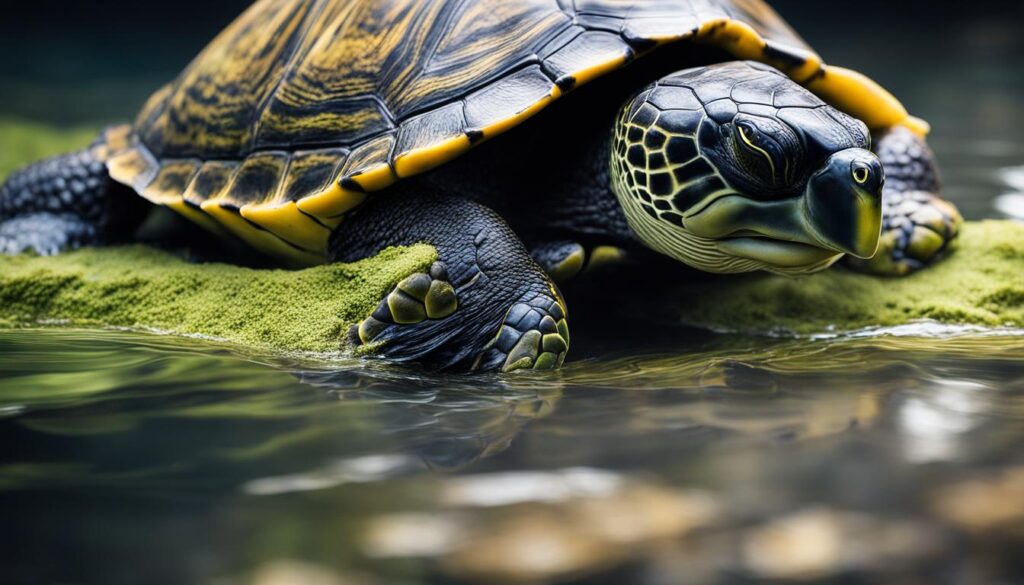
Turtles have long been associated with their slow speed, but it plays a vital role in their survival. Understanding the factors that contribute to their slow movement can provide valuable insights into their unique adaptations and strategies for thriving in their environments.
The Natural Predators of Turtles and Their Speed
Turtles face various natural predators in their habitats, including birds, raccoons, and larger aquatic species. However, their slow speed acts as a form of defense against these predators. By moving slowly, turtles can blend into their surroundings and decrease the likelihood of detection. Additionally, their shells provide protection, serving as a shield from potential threats.
Linking Turtle Speed to Their Life Expectancy
The slow speed of turtles is closely linked to their remarkable life expectancy. Because turtles have a slower metabolic rate compared to many other animals, they require less energy and can sustain themselves for extended periods. This reduced energy expenditure contributes to their longevity, enabling them to live for several decades or even centuries.
Understanding Turtle Metabolism and Movement Mechanics
Turtle metabolism plays a crucial role in their slow movement. Their low metabolic rate allows them to conserve energy and survive on limited food resources. Additionally, the mechanics of turtle movement contribute to their slow speed. Their limbs and body structure are adapted for steady and deliberate motion, providing stability and control while navigating their environments.
Overall, the slow speed of turtles is a result of their evolutionary adaptations and serves as a key component of their survival equation. By moving slowly, turtles can evade predators, conserve energy, and achieve remarkable longevity. Exploring the intricacies of their natural predators, life expectancy, and movement mechanics provides a deeper understanding of these fascinating creatures.
The Exception to the Rule: When Turtles Speed Up
“Not all turtles are slow!”
While turtles are generally known for their leisurely pace, there are remarkable exceptions to this rule. Some turtle species possess the ability to reach impressive speeds, defying the perception of slow-moving creatures. These fast turtles display unique characteristics that enable them to achieve high speeds in comparison to their slower counterparts.
Let’s take a closer look at these exceptional beings who challenge our assumptions:
- The Painted Turtle: Known for its stunning colors, the Painted Turtle showcases impressive swimming abilities. With a streamlined body and strong limbs, this turtle can swiftly navigate through water, reaching surprising speeds.
- The Snapping Turtle: Despite their reputation for aggression, Snapping Turtles have an unexpected talent for speedy movement. With their powerful legs, these turtles can lunge forward quickly, surprising their prey and potential threats.
- The Eastern Box Turtle: Often found in wooded areas, the Eastern Box Turtle impresses with its ability to move at a relatively fast pace for a terrestrial turtle. These turtles demonstrate agility and speed while exploring their forest habitats.
These fast turtles possess unique adaptations, including streamlined bodies, strong limbs, and powerful propulsive movements, which allow them to achieve remarkable speeds. By understanding the exceptional instances where turtles speed up, we gain a deeper appreciation for the diversity and complexity of these fascinating creatures.
Sea Turtles: Agile Giants of the Ocean
When it comes to agility and speed, sea turtles are the true giants of the ocean. These magnificent creatures have evolved remarkable adaptations that allow them to navigate the expansive waters with ease and grace.
Sea turtles’ streamlined bodies and powerful flippers enable them to move effortlessly through the water. Their agile movements make it possible for them to chase after prey, escape from predators, and traverse long distances in search of suitable nesting grounds.
But it’s not just their physical attributes that contribute to their agility. Sea turtles have also developed a deep understanding of the ocean currents, using them to their advantage. They can effortlessly ride these currents, conserving energy while covering vast distances.
In addition to their remarkable speed, sea turtles play a vital role in maintaining the balance of marine ecosystems. They feed on seagrasses and jellyfish, helping to control populations and prevent the overgrowth of certain species. Their movements also aid in the dispersal of nutrients throughout the ocean, benefiting marine life as a whole.
Furthermore, sea turtles are important indicators of ocean health. Their presence or absence can provide valuable insights into the state of the marine ecosystem and the impact of human activities.
Overall, sea turtles exemplify the beauty and agility of marine life. Their ability to navigate the vast expanse of the ocean with speed and grace is truly awe-inspiring. However, it is crucial that we continue to protect and conserve these agile giants, as they face numerous threats such as pollution, climate change, and habitat loss. Through our collective efforts, we can ensure the survival of sea turtles and the preservation of their vital role in the ocean ecosystem.
Conclusion
In conclusion, the slow speed of turtles is influenced by a combination of factors. Their metabolic rate, which is inherently low, contributes to their leisurely pace. Additionally, their lifestyle as herbivores and their specific adaptations for survival play a role in determining their speed. The unique anatomy of turtles, especially their shells, also affects their movement.
While turtles are generally slow, it’s important to note that speed can vary among different species. Some turtle species can move at surprising speeds, challenging the common perception of their slow nature. Understanding why turtles are slow provides valuable insights into their behavior and survival strategies.
Overall, turtles are fascinating creatures with notable characteristics and adaptations. Their slow speed, although seemingly disadvantageous, has proven to be advantageous in various ways throughout their evolutionary history. From conserving energy to minimizing the risk of predation, the slow pace of turtles has allowed them to thrive in diverse environments and ecosystems. Despite their slow nature, turtles are a remarkable example of adaptation and resilience in the animal kingdom.
FAQ
Why do turtles move so slowly?
Turtles have a slow metabolic rate and are well-adapted to conserve energy in their environment. This helps them to survive and thrive in their habitats.
Do all turtles move slowly?
While most turtles are known for their slow movement, there are some species that can actually move at surprising speeds, particularly in the water.
Why are turtles so slow on land?
Turtles are not built for fast movement on land due to their anatomy and physiology. Their shells and limbs limit their range of motion and make them more suited for aquatic locomotion.
Can turtles run away from predators?
Turtles are not known for their speed and agility on land, so running away from predators is not their primary means of defense. They rely on their shells and behavioral adaptations to protect themselves.
How fast can turtles swim?
Sea turtles, in particular, can swim at impressive speeds. Some species can reach speeds of up to 35 miles per hour.
Do all turtles have the same speed?
No, the speed of turtles can vary depending on their species and their unique adaptations. Some turtles are naturally faster than others.
Are turtles slow because they don’t have to chase prey?
Turtles are slow-moving creatures because they have a slow metabolic rate and do not need to chase after prey. Their herbivorous nature allows them to conserve energy and go long periods without needing to eat.
How does a turtle’s shell affect its speed?
The shell of a turtle can add weight and limit its mobility, which contributes to its slow speed. However, the shell also provides protection and is a crucial adaptation for survival.
Why are sea turtles faster than land turtles?
Sea turtles are more streamlined and have adapted specifically for a life in the water. Their flippers and sleek bodies allow them to swim with speed and agility.
Why are some turtles faster than others?
Different turtle species have evolved unique characteristics and adaptations that allow them to achieve higher speeds. Factors such as body shape, muscle power, and environment can influence their overall speed.

